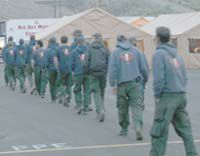| The Lolo Hotshots, an interagency fire team march toward the chow line set up on the grounds of WETC on Friday morning before heading out into the field to face the Mathis fire for another day. A number of hotshot teams worked the fire during its height, along with many other fire fighters from various states around the west and even the mid-west. Presently two outside state teams are still on the fire line. |
The Mathis wildfire was 100 percent contained last Friday evening.
The containment area of about 1,900 acres is still burning, consuming what fuel is left at the site.
The fire lines established around the edges of the burnt out area have been holding and officials expect the flames to be totally out in a few days.
The federal incident team which had been in place for a week left the area on Sunday. Many of crew members headed to fires in southern Idaho where a blaze has been raging in the Sawtooth National Forest.
During the weekend, federal representatives pointed out that the success of the local firefighting effort was due in large part to the cooperation United States agencies had with local officials.
“The links between all the local agencies has been fantastic,” said Richard Harvey, who until Saturday acted as the incident commander for the firefighting effort. “We have had total cooperation from all the agenices involved.”
Federal fire officials are usually dispatched to a fire that gets too big or poses a large threat to a community in any state in the union.
In the case of the Mathis wildfire, the danger to the town of Kenilworth, power lines that run through the area and the coal mining operations was the impetus for sending in out of state and federal teams to help control the blaze.
Cooperative agencies included.
•The United States Bureau of Land Management.
•The United States Forest Service.
•Carbon County – emergency services, commissioners, sherriff’s department, road department, GIS and airport.
•Utah American Energy.
•Helper City Fire Department.
•Wellington City Fire Department.
•Price City Fire Department.
•College of Eastern Utah through the Western Energy Traning Center.
| Fire response vehicles climb into a smokey Dry Canyon on Friday morning to more control work on the Mathis fire. Dozens of vehicles, hundreds of fire fighters at four helicopters finally brought the fire to its knees toward the end of the week. Local management has now taken over the fire that remains. |
The fire management team utilized WETC for the incident’s command headquarters, including everything from finanacial management to logistics set up there to fight the fire.
“Dealing with a fire like this a lot like fighting a war,” pointed out Harvey on July 13, shortly before the Mathis blaze was declared contained. “It takes everyone and a lot of materials to handle a situation like this.”
Fire fighters from as far away as Missouri helped to battle the blaze that started on July 5 when lightening struck the ground and ignited the blaze on private property owned by the Mathis family.
A plan was drawn up by fire officials to contain the fire and to keep it from spreading. That was the plan that all fire fighters worked toward in the week the blaze threatened to burn more than juniper, grass and timber.
At the July 13 briefing, Lane Adair from UtahAmerican Energy told fire fighters that the company and employees at Aberdeen mine owe the emergency personnel a great deal for their hard work and sacrifice.
UtahAmerican owns the coal mine which could have been threatened by the Mathis wildfire.
“I just wanted to tell you all thanks for what you have done in protecting our property,” commented Adair “We are very grateful to you.”
The fire also burned within about two miles of Kenilworth on the cliffs above the town.
Kenilworth residents were uneasy during the first few days of the wildfire. But after last Wednesday, the threat subsided and people relaxed.
The cost for fighting a wildfire like the Mathis incident is extremely high.
“Right now, the fire has cost about $2 million,” said Bob Trodahl, the assistant incident commander last Friday. “But the total cost of the fire may not be known for a year. A lot of the fire fighters are paid by their local entities and we sometimes don’t get all the costs in for quite a while.”
Trodahl indicated that the total costs for the blaze would probably range between $2.5 to $3 million if nothing changes.
During a range fire, significant revenues are expended on manpower and expensive equipment that costs a lot to run.
For instance, just one of the sky crane helicopters is estitmated to cost $8,000 per hour to operate.
At one time, there were four helicopters and one fixed wing aircraft fighting the Mathis wildfire directly or conducting observation on the blaze.
Logistically, supplies poured into WETC during the fire. Boxes, extra equipment and supplies were piled up outside the headquarters building.
During the weekend, the management of the fire was taken over by an incident command led by Hal Stevens of the Price BLM office.
While the present fire management effort is local, the primary firefighting crews are from Idaho and Missouri.
“Right now, it looks like we should be on this fire at least another day,” said Stevens on Monday evening. “We had some torching on the west end of the fire on Sunday evening because of the wind. But it is still within its containment area.”During that time, crews remaining on the line will mop up hot spots and watch to make sure the fire does not get outside the boundaries of the established containment area.

